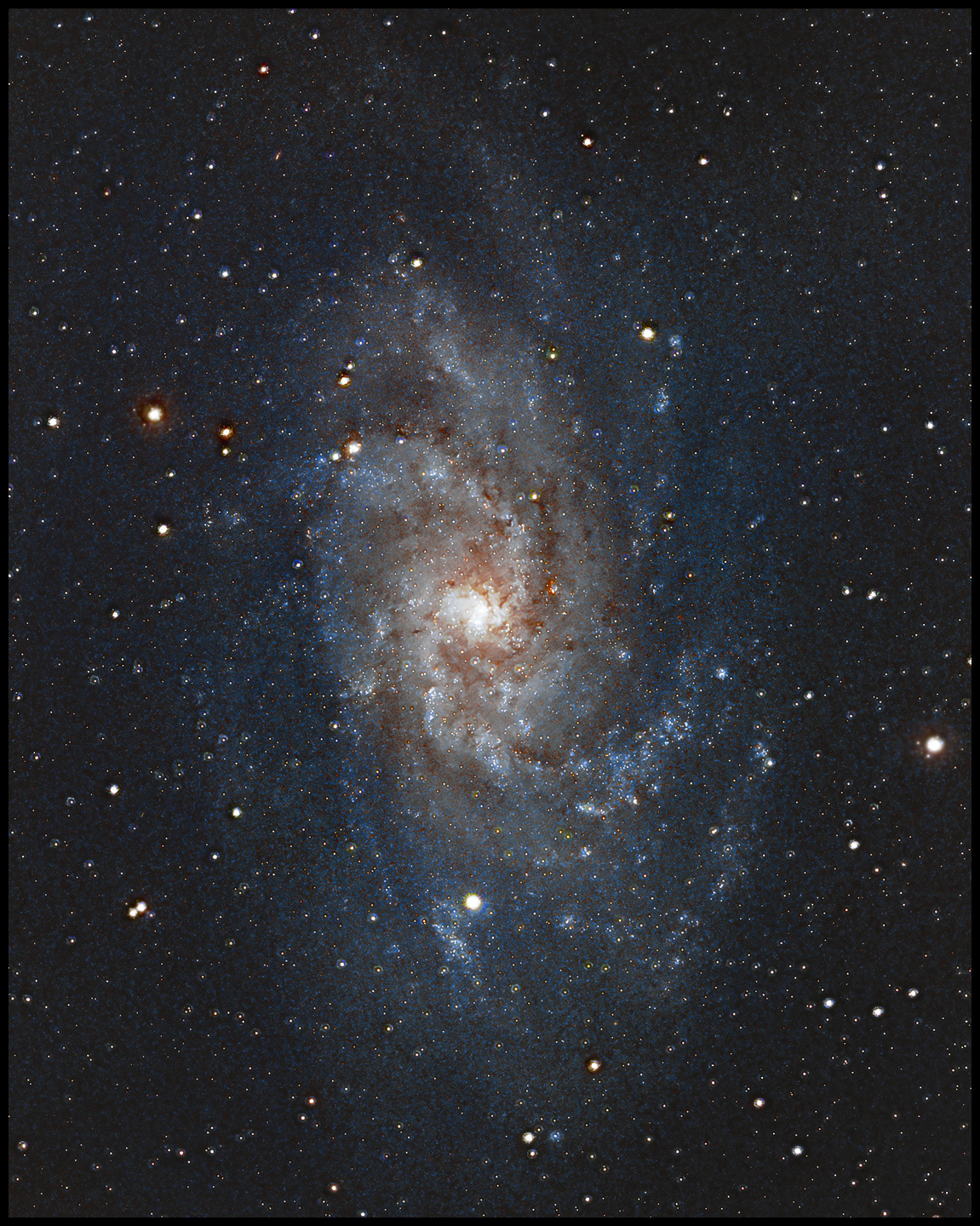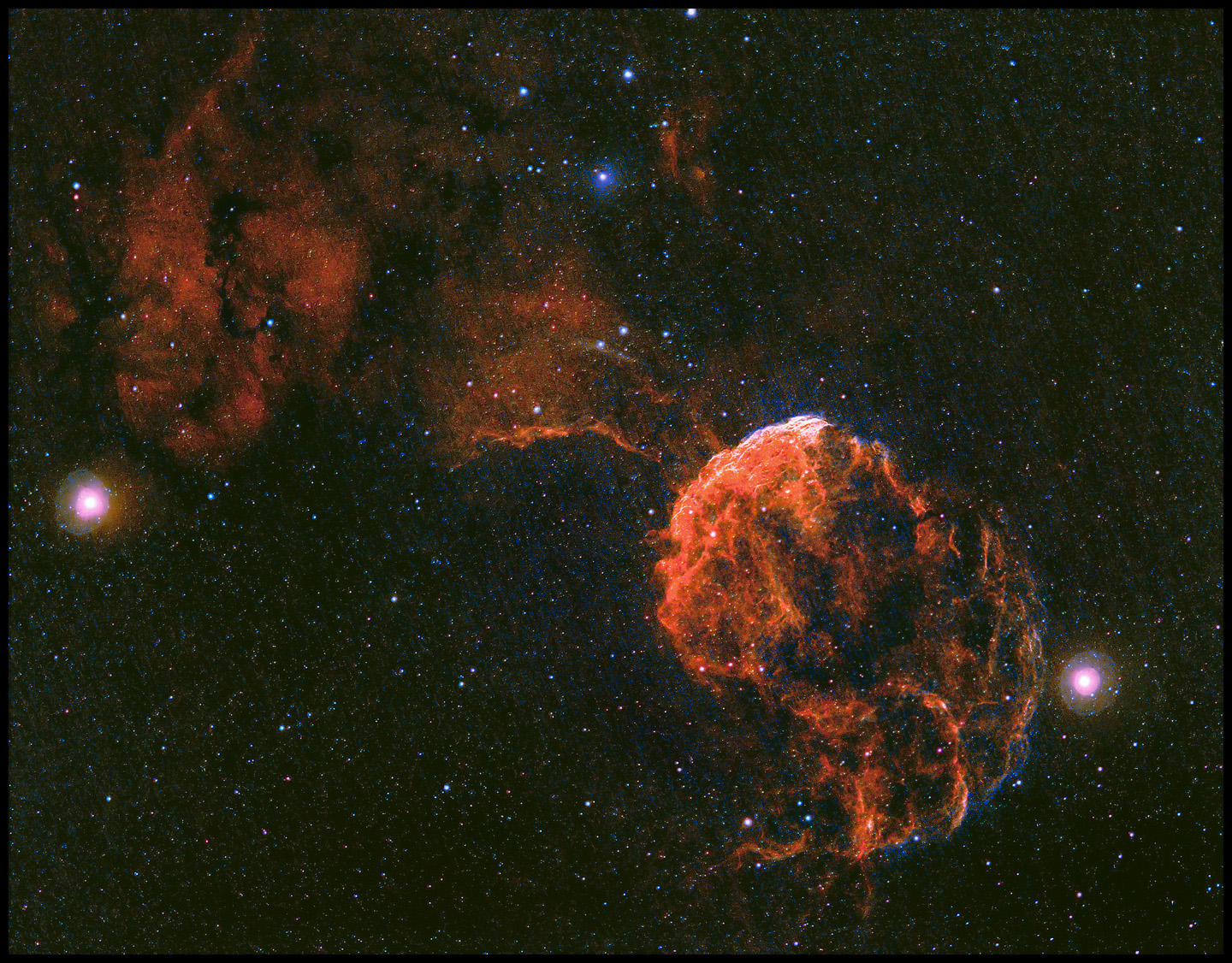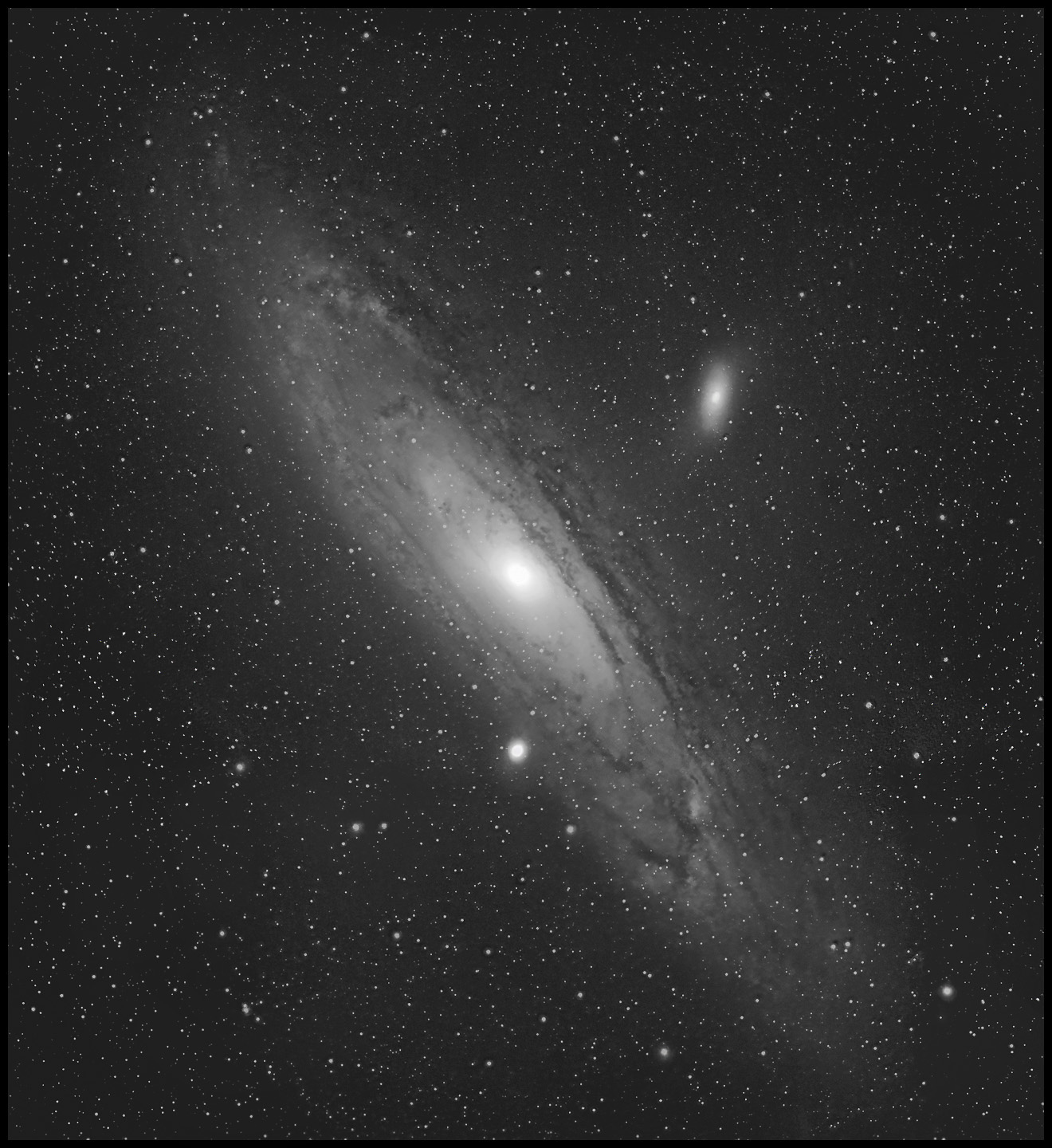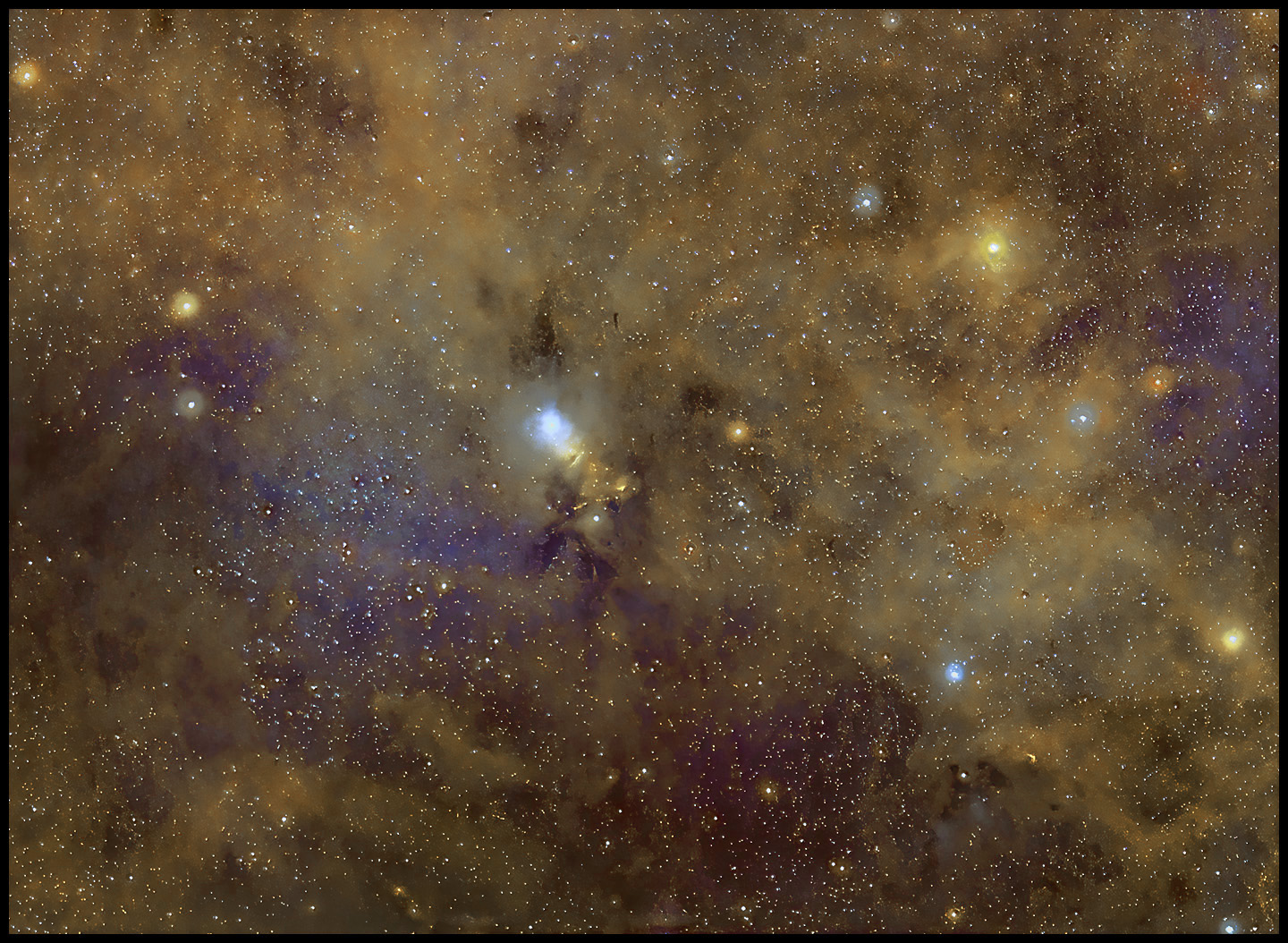The Starry Night, 269 :: home :: |
I built an observatory...
I moved the A-P mount north from under the trees and realigned it on Polaris. I recalibrated its servos on Deneb and then used a Bahtinov mask to focus on the same star. I took weeks to get around to trying it on the 400mm Nikkor (aka, the fast, flat-field 6-inch refractor), but the mask works very well with that lens in both broadband and dual band applications. Tonight: M33, M45, and IC 443. Each paraded through our gap in the pines. At 7 PM, I began a sequence of 60s, RGB images of M33, this time absent the conifer filter.
Click any of these for a better look. Please!
From M33, it's just a short commute to M45. I refocussed with the mask ('twas but a tweak) and a little after 10 PM began a series of 30- and 60-second exposures. I probably should have done 10 and 60, but it's out there running, and I'm in here typing, so I'm going to leave it alone. I should be able to recover decently tight bright stars, and if I can't then I'll collect shorter exposures eventually. The exact stretch that best reveals Tennyson's "silver braid" can be elusive (it's farther left in the histogram and occupies a narrower range than I expected). I just kept messing until I found it. I eventually did a starless stretch and layered the stars back in:
After M45, IC 443. Wednesday night looks good, but why not tonight? I gathered 10x30s of RGB star data at unity gain (139), then changed to the dual band filter. At 1 AM, I launched a 2-hour series of 60s frames with gain 300. We'll see how many I actually take before calling it a night (all of 'em!). Significantly, the computer has delivered all this with power to spare and without a battery change. The image makes no use of the RGB preliminary data. It's dual band all the way down:
I'm pretty sure I've got a lot to learn about putting the O-iii data in the B pixels to work. In fact, there are enough subtleties about this multi-band OSC workflow to keep me entertained for a good long while.
2025/01/01. A bigger lithium battery and approporiate charger arrived yesterday, about a week ahead of schedule. The 50AH unit fits the Kendrick battery bag I used for a 20AH battery just as expected (sideways). On the first day of 2025, I've wired up the distribution kit (USBx4, 12Vx2, voltmeter, and power switch) together with the battery's supplied, dedicated charger. When the mood strikes, I can again image without being tethered to a Duke Energy nuclear reactor. Open skies beckon. First, let's do a dry run down here. I set up expecting to do a long run on NGC 891, but it was still in birdfeeder tree. So I turned to similar-sized NGC 7331 for a reality check. As suspected, these smaller galaxies are really small in the 400mm. So I opted for a two panel mosaic of M31 instead. In thinking about such a thing recently, I'd decided that 3 panels would be needed, but looking at live data on the screen, I think 2 will be a plausible first cut. Ninety minutes north and south it is. M31 will probably overflow the sensor, mosaic notwithstanding. Think of it as another reality check, but one with a decent amount of data and maybe a nice photo into the bargain. We'll know what to do next time:
I accidentally left the camera in Bin2 mode, effectively cutting resolution in half (or worse). But also rendering the image basically noiseless and cutting processing time to a fourth what it would have been. I've presented this one in b/w because color-balancing M31 is always a pain, and that can wait for a better pile of data. Actually, I may well continue in Bin2 for a few more nights and worry about maximizing resolution later. Let's see what we get. After M31, I intended to bring the computer in and check out the take, but the sky was clear. I centered NGC 1333 amid the dark clouds of Taurus. This is another effort whose point is to understand what's needed when I really do try to get it. Tonight's data will inform future tries. [First lesson: try gain 300. That's a really dark subject!] 2025/01/03. One more night made all the difference for NGC 1333. After 101 frames, I had basically nothing; after another 125, I have this:
I thought this was a star-forming region in the Taurus molecular cloud, but it's actually in more distant Perseus molecular cloud. Our line of sight to the PMC grazes the outer bits of the TMC. Here are all the details. The top half of this frame is in Perseus, the lower left is in Taurus; the lower right is in Aries.
Here's the plan for M31: First, take plenty of data in two fields, one of the northern portions of the M31 complex and another of the southern field.Then take an "establishing shot" of the starfield (a 4-panel mosaic of fairly short exposures with the center of M31 at the center of the mosaic -- I did a likely prototype tonight, 10x30s for each quadrant which for this purpose will probably need to be redone for better uniformity, better depth, and better star colors). Process the two deep fields in starless mode, then map them back into the starfield mosaic. Acquire color data for M31 later if it can't be extracted from images in hand. Tonight I took Bin1 and Bin2 flatfields using a diffuser in twilight. Then I tried to get some Bin2 darks but messed up. I collected 95 frames of the northern deepsky field, then the starfield mosaic, then returned to get 35 more of the northern field -- I want at least 100 tonight; between clouds blowing through and my early start (in deep twilight), a few extras can't hurt. If the weather holds, I'll finish with some frames of the southern field and then try again to get 60s bin2 darks. If the flats and darks help at all in this project, I'll acquire a better set of each. Weather is going to close down soon and the Moon is growing, so I'm pushing to take data while I can.
2025/01/04. I completed the M31 data collection (seven hours for M31-South and seven for M31-North or close enough) but with a couple of misadventures. The last 30 frames of M31-South trailed very slightly but very uniformly in RA. Cable drag? I saw none when I went out to check. Balance? The 400mm is a trivial load for the A-P mount. Most of last night's data was collected at -6C rather than -15C. The darks were also shot at -6C, so that's no real problem, but why? This morning, I reconnected everything and note that the ASIStudio deep sky module inserts -6C for the sensor target when I turn on the cooler. Has it always? How's it pick that temperature? Anyway: add it to the to-do list at the start of a session: confirm temperature and reset as needed. (Longer term, find an alternative to ASIStudio.) A quick trial with darks and flats says the -6C data is fine to use. But the color balance is off, so now I'm considering how best to keep the flat from influencing the color of calibrated images (convert to gray and then back to RGB? Take saturation to zero?). In the meantime, let's forego color. Next page!
:: top :: |
© 2025, David Cortner



